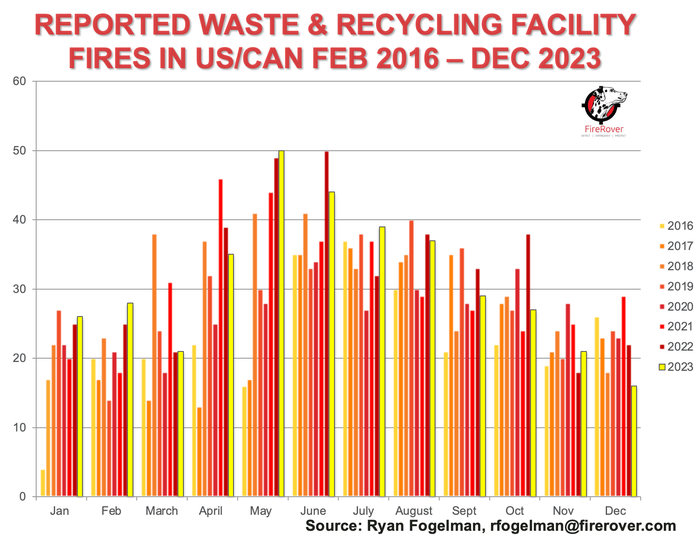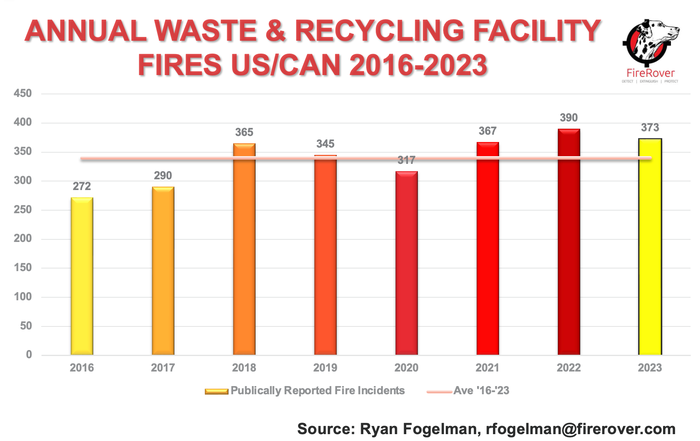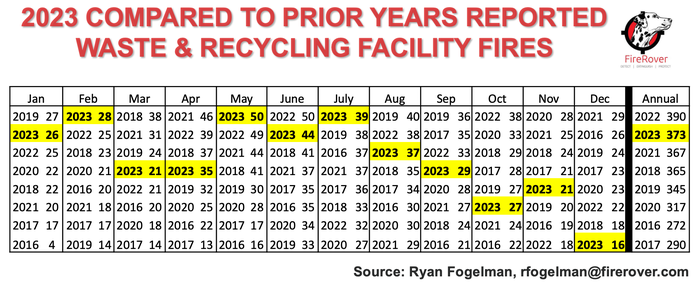January Fire Report: Do We Finally Have a Handle on the Lithium-ion Battery Problem?
Based on the waste and recycling industry's track record, Ryan Fogelman says we will see a turn in reported fires at some point. Hopefully 2023, with fewer fires than 2022, is the watershed year where the industry finally start seeing a trend of decreasing fires in 2024 and beyond.

The final numbers are in, and the good news is we finally stopped the three-year trend, coming in just below the high-water mark of 390 publicly reported fires that we incurred in 2022. In 2023, there were 373 unique fire incidents reported at waste and recycling facilities in the U.S. and Canada, and based on reasonable assumptions, we can extrapolate that 2,400-plus facility fires occurred last year. Now the work begins …
December 2023 Fire Data
We encountered 16 publicly reported fire incidents in December 2023 at our waste and recycling facilities. Of those incidents, eight occurred at scrap metal recycling facilities, four occurred at waste, paper and plastic facilities, four occurred at organics facilities, two occurred at construction and demolition (C&D) operations, one occurred at an electronic battery recycling operation and one occurred at a hazardous material operation. At Fire Rover, we responded to 250-plus hot spots and/or fire incidents at our clients’ facilities.

In 2023, we experienced 373 unique reported fire incidents, and based on reasonable assumptions, we can extrapolate that 2,400-plus facility fires occurred in the past 12 months in the U.S. and Canada. During that time, we also experienced 65 reported injuries and two deaths, most of which were the fire professionals responding to these events.

As we break down these fires further into months, it’s important to note that 2023 started out hot with five of the first seven months of the year at record or close to record months for these events.

As the second half of 2023 unfolded, we were fortunate to see the number of monthly fires come down to only 16 fires in December, the lowest number we have ever experienced during December since I began reporting these fire events in 2016. I am cautiously optimistic that 2024 will continue to plateau or experience a downward trend, but keep in mind that 2023 was our second-worst year for reported fires on record.
When I started sharing my worries in 2016 and 2017 that we were headed for a wave of lithium-ion batteries, I shared my belief that there is a three-fold solution to this problem: 1) Education, 2) Operational Best Practices and 3) Investments in Technology.
Education: At many levels of the industry, education of the public on the potential dangers of improperly placing batteries in our waste and recycling streams is already underway. Personally, I believe local campaigns are the most effective when they target specific pockets of “bad actors” for specific routes.
But we mustn’t miss educating the commercial customers as well. We need to drive home that certain actions that used to be OK will not fly anymore. For example, disguising containers of hazmat material to be recycled at a C&D facility is not OK; this material should be sent to an environmental services provider. It is also not OK to act first and then ask for forgiveness anymore. The stakes are too high.
Operational Best Practices: Regarding the waste and recycling industry in the U.S. and Canada, the operators have been working on developing and continuously improving their operations, especially since the lithium-ion battery shock that occurred in 2018.
The industry has been dealing with fires since its inception. No matter what the public perception is, only one in two fires at our waste and recycling facilities are due to batteries. How do I know this besides reading all the surveys I have seen? The summertime spike is not caused by “batteries.” Think about it. The batteries we see in our waste and recycling streams should remain pretty steady throughout the year. There may be an increase of disposed electronics during spring cleaning, but that wouldn’t account for the months-long spike we experience. What we do see during the summer months are more propane tanks, fireworks, BBQ briquettes and more. These materials, along with the heat/dryness, increases the number of fire incidences.
Our waste and recycling operators are doing an amazing job dealing with a new hazard that increases the risk of issues inside their operations. The reality is we are being inundated with these batteries, and the numbers are only going in one direction. If we can stop the “major” and “catastrophic” losses that occur once a fire gets out of control, we will all be better off.
Investments in Technology: My idea has always been pretty simple: As we continue to successfully protect our customers' facilities with “Fire Rover client saves” and grow our install base, we will have more Fire Rover client saves, so the number of “reported fires” will decline. Unlike other countries that are years behind the U.S. and Canada, we have Fire Rover systems installed at 500-plus materials recovery facilities, transfer stations, scrap metal yards, electronic/battery recycling facilities, hazardous material recycling facilities, rubber recycling facilities, C&D operations and more.
Based on our track record alone, we will see a turn in reported fires at some point. Hopefully 2023, with fewer fires than 2022, is the watershed year where we finally start seeing a trend of decreasing fires in 2024 and beyond. Keep in mind the forecasted numbers for manufacturing of lithium-ion batteries have been increasing at a compounding rate for at least a decade and show no signs of slowing down or being replaced by a safer technology. Additionally, we have yet to know the real gains we are experiencing due to the public education on properly disposing of these batteries at drop-off sites versus improperly adding them to the curbside bins.
Conclusion
The work on the “7th Annual Reported Waste & Recycling Facility Fires Report” begins. I have spent the year compiling the data, and now it is time to consolidate and analyze it to see what new insights we have gained over the years.
This year's report will be sure to include the Fire Rover performance scorecard that highlights the number of fires/hot spots responded to, the number of pressurizations of our systems, the number of times we suppressed fires and the number of dispatches to the fire professionals/fire brigade. It also will include the latest death/injury report, which shows that more than 9% of the 373 fire incidents we incurred in 2023 resulted in an injury or death; a state-by-state (province-by-province) analysis of how your locality is performing from a tonnage and site number perspective; and much more data and information. If you would like to reserve a digital copy of my report upon release, you can enter your information at https://lnkd.in/dgAX9Ze or subscribe to my LinkedIn 🔥 Fire Safety Report 🔥 newsletter at https://lnkd.in/gjwNpSph.
About the Author
You May Also Like




.png?width=300&auto=webp&quality=80&disable=upscale)